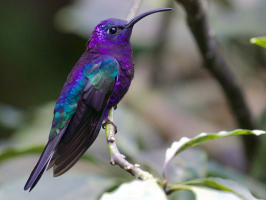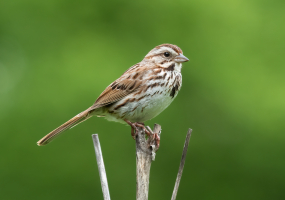Top 10 Australia's Most Beautifully Coloured Birds
Australia is a place of mystery and wonder. It’s home to some of the most unique animals, plants, and wildlife on earth. Australia is also home to many famous ... read more...birds that you may have heard about or seen before. Some Australian birds are known for their audible abilities, some for their size, and others for their spectacular colourings. Here is a list of Australia's most beautifully coloured birds, let's find out!
-
The Gouldian Finch (Chloebia gouldiae), also known as the Lady Gouldian finch, Gould's finch, or the rainbow finch, is a colorful passerine bird that is native to Australia. Black, green, yellow, and red marks can be found on either sex. The colors of the females are typically less vivid. The male's chest is purple, while the female is a paler mauve, which is one obvious difference between the sexes. Gouldian birds measure between 125 and 140 mm.
The heads of Gouldian finches can be red, black, or yellow. It is now understood that what were once thought to be three distinct species of finches are actually color variations that can be found in the wild. Selective breeding has also produced changes in the color of the body and breasts (blue, yellow, and silver instead of a greenback). At the back of the gape, there are a number of "prominent rounded tubercles" with an "opalescent lustre". Even though there is a wealth of scientific evidence to the contrary, these tubercles are frequently (and mistakenly) described as phosphorescent. These tubercles are thought to be reflective only and not luminous.
Wikipedia 
Wikipedia -
The Rainbow Bee-Eater (Merops ornatus) is a near passerine bird in the bee-eater family Meropidae. In the summer, most of southern Australia, excluding Tasmania, can be found with Rainbow Bee-eaters in forested areas. During the winter, they go northward into northern Australia, New Guinea, and a few of Indonesia's southern islands. A vagrant has been recorded on Miyako Island, Japan.
The brightly colored Rainbow Bee-eaters grow to be 23–28 cm long, not including the expanded tail feathers and weigh 20–33 g. Green makes up the upper back and wings, while vivid blue makes up the lower back and under tail coverts. The undersides of the wings and the primary flight feathers are rufous to copper with green borders and black tips, while the tail is black to deep violet. The two central tail feathers of the Rainbow Bee-eater are longer than the other feathers and are longer on males than females. Its stomach, breast, and throat are all pale yellow-orange in color, and its gorget is black with a black stripe that is edged with white. It has a pale yellow-orange throat, stomach, and breasts. It also has a black crescent-shaped gorget and a black stripe that runs through its bright red eye and is edged with blue. Their syndactylous feet are tiny (i.e., with toes partly united). The juvenile's tail streamers and neck bands are absent, and its crown is greener.

eBird 
eBird -
The Azure Kingfisher (Ceyx Azureus) is a small kingfisher in the river kingfisher subfamily, Alcedininae. The azure kingfisher inhabits parts of Tasmania, northern and eastern Australia, the lowlands of New Guinea, and nearby islands, as well as North Maluku and Romang. The contact zone between the New Guinean subspecies and the mainland Australian subspecies is between Simbu Province and the northern Huon Peninsula, as well as south of Cenderawasih Bay, on the east coast of Far North Queensland between Cairns and Princess Charlotte Bay.
The azure kingfisher is 17–19 cm long and weighs between 29–32 g for the male and 31–35 g for the female. It has a deep blue to azure back, a huge white to buff spot on the side of the neck and throat, and a rufous buff with some blue-violet streaks on the breast and flanks. It is a very colorful bird. There are only two forward toes on the red foot. Except in the front view, when they stand out as two sizable white spots resembling eyes, the lores (the area between the eye and the bill) are white and barely noticeable. These spots may serve as a deterrent to potential predators.

iStock 
eBird -
Australia is home to the Rainbow Lorikeet (Trichoglossus moluccanus), a species of parrot. The eastern seaboard, from northern Queensland to South Australia, is characterized by its prevalence. Its habitat is rainforest, coastal bush, and woodland areas. Previously classified as subspecies of the rainbow lorikeet, six taxa are now considered distinct species.
The rainbow lorikeet is a medium-sized parrot that weighs between 75 and 157 g and measures between 25 and 30 cm long, including the tail. As with all subspecies, the nominate race has extremely vivid and colorful plumage. The upper body, including the wings, back, and tail, are all green, with the head being a deep blue color with a greenish-yellow nuchal collar. It has an orange-yellow chest. The thighs and rump are green, while the belly has a deep blue color. A yellow wing bar and the red underwing coverts stand out sharply in flight. The visual differences between the sexes are minimal. A black beak is present in juveniles; it gradually turns orange in adults.
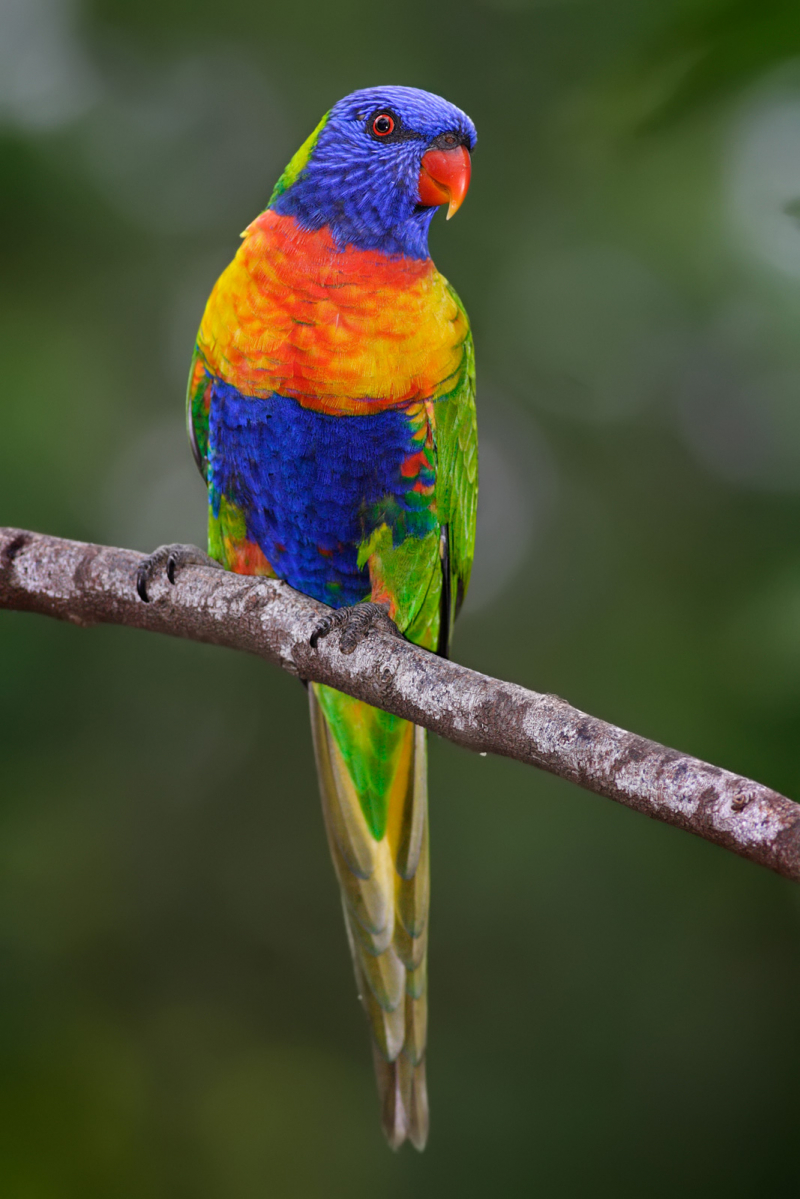
Wikipedia 
Wikimedia Commons -
The Splendid Fairywren (Malurus splendens) is a passerine bird in the Australasian wren family, Maluridae. It is also known simply as the splendid wren or more colloquially in Western Australia the blue wren. From central-western New South Wales and southwestern Queensland to coastal Western Australia, the Splendid fairywren can be found throughout a large portion of the Australian continent. It mostly lives in dry and semi-arid areas. The male of this species, which has a high degree of sexual dimorphism, is a tiny, long-tailed bird that is most vivid blue and black in color. Since all dull-colored birds were mistaken for females in the beginning, non-breeding males, females, and juveniles were primarily grey-brown in color. This produced the early impression that males were polygamous. It includes numerous related all-black and all-blue subspecies that were formerly thought of as different species.
The Splendid fairywren shares some unusual behavioral traits with other fairywrens, including social monogamy and sexual promiscuity, which means that even while they form pairs with one male and one female, each partner will mate with other people and even help raise the young from such trysts. As part of their courtship display, male wrens collect pink or purple petals and hold them out to the females.

Wikipedia 
eBird -
The Mulga Parrot (Psephotellus varius) is endemic to arid scrublands and lightly timbered grasslands in the interior of southern Australia. The Mulga Parrot is a medium-sized parrot with a long tail and reaches approximately 27–32 cm in length with a 30-42 cm wingspan. It weighs 50–60 g. The species exhibits sexual dimorphism, with distinct differences between the sexes' plumage. The alternative common name many-colored parrot is derived from the fact that the male mulga parrot is colorful. Overall, it has a vivid green color, although there is a bluish tint on the neck and above the eye, and the breast is whiter. It has a pale green rump. There is a crimson patch on the back of the skull, and the forehead is yellow.
With the exception of the yellow median wing coverts and the blue outer webs of the primaries, the lower belly and thighs are marked with orange-red, and the wings are greenish. The long tail has a variety of colors: the two long core feathers are a dark blue with green undertones, the outside feathers are a blue that fades to white, and the higher tail coverts have some red. Its iris is brown, and its bill is blue-grey with black edges. The overall appearance of the female is duller; she has an olive-brown head and chest, a duller yellow forehead, a duller red patch on the back of the head, a pale green belly, and a more brown-grey beak. It occasionally also sports a crimson shoulder.
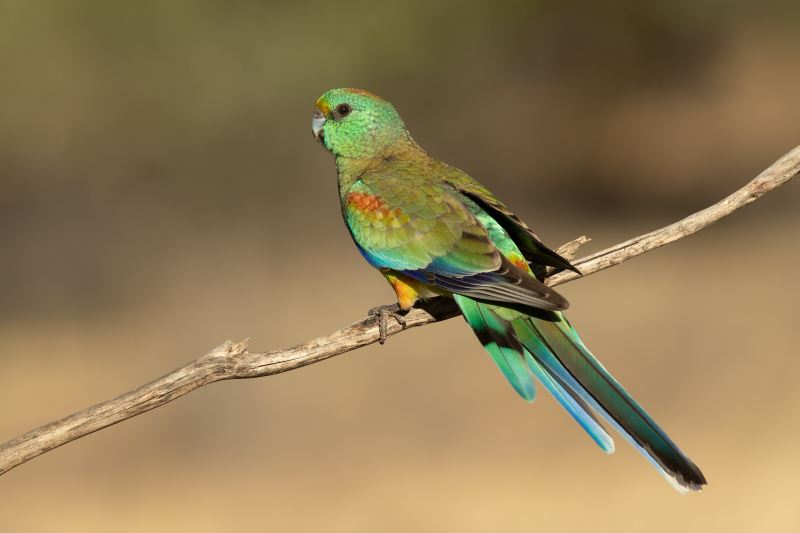
Wikipedia 
eBird -
Southeast Australia is home to the diminutive passerine bird known as the Pink Robin (Petroica rodinogaster). Cool temperate woods in remote southeast Australia are its natural home. It is sexually dimorphic, like many Petroicidae brightly colored robins. The robin is a little, thin-billed bird that is 13.5 cm long with dark brown eyes and legs. The male has a pink breast, a distinguishing white mark on his forehead, and grey-black upper parts, wings, and a tail. The stomach is white. The female's feathers are gray-brown.
The pink robin and its Australian relatives are not closely related to either the European or American robins, but rather appear to be an early branch of the Passerida group of songbirds, hence its position on the passerine family tree is unknown. September through January are the breeding months. The nest is a clean, deep cup constructed of moss. The nest is often built in a tree fork up to 5 meters (15 feet) above the ground using spider webs, feathers, and hair for binding or filling. There is a clutch of three to four eggs laid. The 18 by 14 mm-sized eggs are characterized by dark brown and lavender splotches and spots, which are typically concentrated near the large end. They are also greyish, greenish, or blueish white.
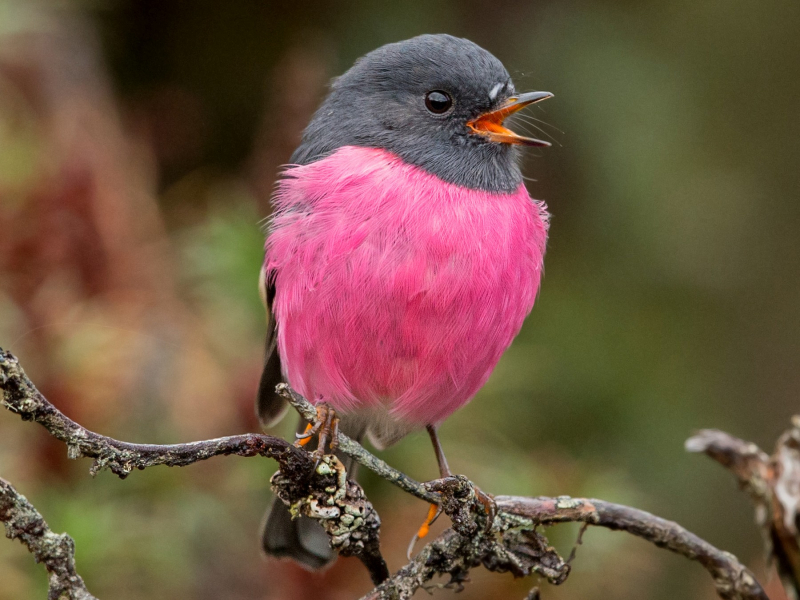
eBird 
Australian Geographic -
The Eastern Rosella (Platycercus eximius) is a rosella native to southeastern Australia and Tasmania. The species is found in lightly wooded country, open forests, woodlands, gardens, bushlands, and parks. Although summer might be used if necessary, eastern rosellas typically breed in the spring. The range is 2 to 9 eggs. In the wild, their breeding depression is 30 meters (98 feet) up a tree, 1 meter (3 feet) deep. The primary indication that eastern rosellas would be reproducing is that they feed one another.
Eastern rosellas measure 30 centimeters in length. It has white cheeks and a redhead. The irises are brown, and the beak is white. The lower breast is yellow, fading to a faint green color over the belly, while the upper breast is red. The scalloped look of the black back and shoulder feathers, which vary slightly between subspecies and sexes, is caused by their yellowish or greenish borders. The tail is dark green, while the wings and lateral tail feathers are bluish. They have gray legs. The female is identical to the male but has duller coloring and an underwing stripe that the adult male lacks. Young birds have an underwing stripe and are duller than females.
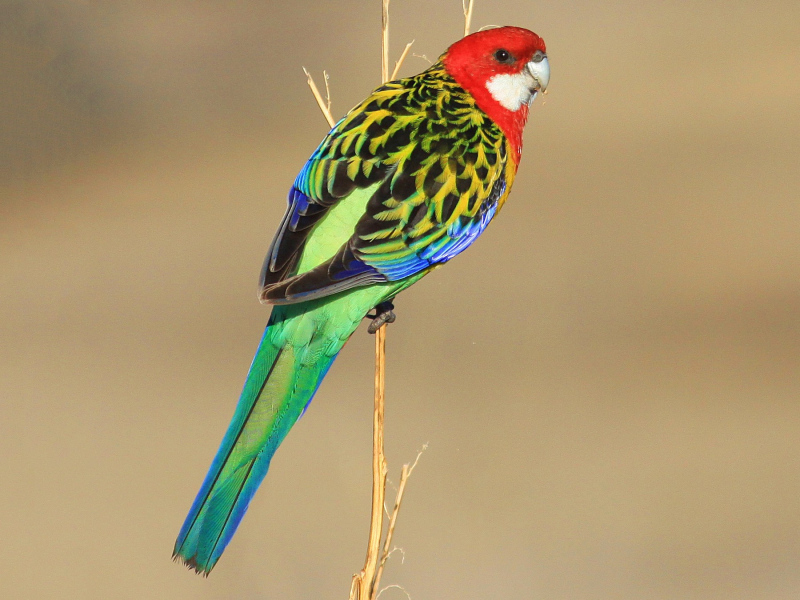
eBird 
eBird -
The Red-Winged Parrot (Aprosmictus erythropterus) is a parrot native to Australia and New Guinea. It is found in grasslands, savannah, farmland, and woodland. Although the birds normally reproduce in the spring and summer, this might vary depending on where they are. Breeding birds typically use a hollow area 11 meters up in trees as their nest. Typically, three to six white eggs, each measuring 31 mm in length, are laid per season. While the male looks for food, the female lays her eggs. About five weeks pass while the chicks remain with their parents.
The average length of a red-winged parrot is between 12 and 13 inches or 30 to 33 cm. Brilliant red wings and a bright green body are shared by both sexes. The male birds have grey feet, an orange bill, a lower blue back and rump with a yellow tip, and a black neck. The wings of female birds are trimmed in red and pink, while their bodies are a yellowish-green color. Dark irises and pale blue color on the lower back help to identify females. Juveniles are primarily colored like females, with the exception of their orange-yellow beaks and light brown eyes. Females reach adulthood at around the age of one and a half years, while males do so around the age of two.

eBird 
eBird -
The Scarlet Robin (Petroica boodang) is a common red-breasted Australasian robin in the passerine bird genus Petroica. The species can be found on mainland Australia as well as on some of its offshore islands, such as Tasmania. The species was first split in 1999 by Schodde and Mason, and because Gmelin's original collection came from Norfolk Island, it kept the name multicolor and is currently referred to as the "Norfolk robin".
The scarlet robins are large-headed passerines with stocky bodies, just like the other Australasian robins. They weigh between 12 and 14 g and are between 12 and 13.5 cm long. It has sexually dimorphic plumage. The males have fiery red breasts, black heads, backs, and tails, as well as black and white wings, a white abdomen, forehead, and rump. The female has a pattern that is identical to the male's, but she is duller, with brown plumage rather than black, a lot more faded red on the breast, and a buff belly. Birds in their juvenile years resemble females but lack the reddish wash on the breast.

eBird 
eBird














